Minkisi – Power Figures & Nail Fetishes from Central Africa
PRIMITIVE - Friday, January 08, 2016By Misaki Imagawa
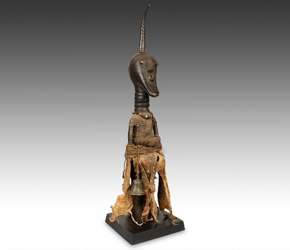 |
|
Do you believe in ghosts, spirits or even a sixth-sense; some power beyond perception, logic or science? Although you may be skeptical, throughout history virtually all cultures have exhibited a prevalent belief that there is a force somewhere out there; a force beyond our control that can be harnessed to solve problems, bring good fortune, and resolve conflicts. Most often, this force has been called “divine intervention,” but whatever it’s called, the belief it exists can be found just about everywhere in the world. Here, in the west people often say "here in spirit" or use the phrase "Guardian Angel," implying that unseen forces ascribed with a personality can intervene in our affairs. In many African cultures, it is believed that ancestor spirits are the supernatural forces – guardians who provide protection and bring good fortune to their living descendants. As the ancestors live in the spirit world – the world of the divine – we might call this divine intervention too.
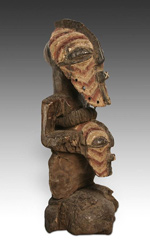 |
|
Many tribes inhabiting the Congo lands in Central Africa are known for their impressive carved figures imbued with unique spiritual power. European colonizers first came across these objects and recognized them as 'fetishes.' They saw them purely as tools of barbaric devil-worshiping rituals; however, they failed to understand the full scope, depth and complexity of the purpose behind them. These artful figures are known as nkisi (pl. minkisi). The objects alone do not possess ‘dark magic’ as the Europeans first assumed; but instead, are considered receptacles for spirits to inhabit, bearing unseen and unrivaled powers from the world of the dead. Through the creation and use of minkisi it was believed a priest, named the nganga, was able to harness these powers, using it to cure illnesses, protect against witchcraft, bring justice to wrongdoers and resolve social dilemmas. In other words, the nganga was able to establish divine intervention.
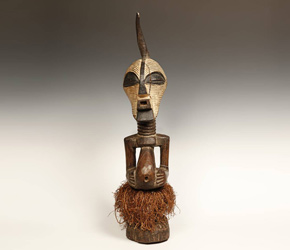 |
|
Most often minkisi are wooden carvings of anthropomorphic or zoomorphic figures, but they can also be shells, gourds, horns and clay pots used for the same purpose. To create minkisi, the nganga first commissions a figure from the village carver or carves the figure himself. These “naked” figures usually include a hollowed head or stomach, considered to be spiritual focal points. The nganga then endows the statue with power by placing spiritually charged materials inside the hollows before sealing them with resin. Think of these materials as batteries, although they are commonly referred to as 'medicine.' The medicine can be a variety of objects or materials associated with the dead such as earth collected from graves, bones, white clay or red ochre. Depending on the specific use and purpose of the minkisi they are then adorned with stones, leaves, feathers, shells, hair, horns, clothing, chicken blood, mirrors, nails, and metal shards. Repeated use, care and devotion give minkisi character and individuality, making each a unique and profound work of art.
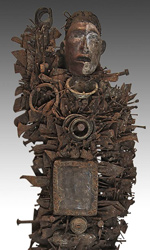 |
|
One figure that stands prominent among all minkisi is called nkisi nkondi from the Bakongo people. This type of figure is commonly called a “nail fetish” and is one of the most recognizable and collectible figures in all of African art. These life-like figures are instantly identified by the many nails, pegs, blades, and shards that are hammered into them. Each individual “insertion” represents one of three things: an oath or agreement between two parties, a pledge to provide protection against enemies and witchcraft, or a vow of vengeance. 'Nkondi' literally means 'hunter;' and it is generally considered an aggressive entity. The imposing presence and implied power of nkisi nkondi is certainly enough to keep anyone committed to a promise or agreement. Like other minkisi, powerful medicine is usually stored inside the belly, which is then covered by a piece of glass or mirror. The reflective surface represents the world of the dead and the vision of the spirits.
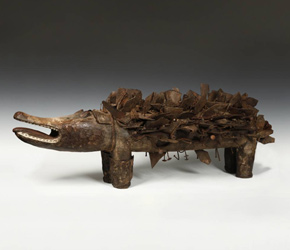 |
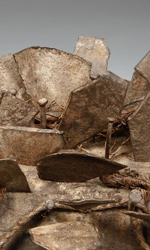 |
||
Similar to the the nkondi is the nkisi kozo; which is the figure of a dog also covered in nails and other objects. The Bakongo people, found in the Republic of Congo all the way to Angola, believe the dog is a mediator between the living and deceased because it lives in the villages of the living, but hunts in the forest where the dead are buried. Like nkisi nkondi, nkisi kozo are considered hunters and exceptionally powerful objects in the hands of the nganga. They are not so much an actual representation of a dog, but rather, a visual statement about movement between the worlds of the living and the dead and the capacity to hunt evil, wrongdoing or negativity. When a nkisi kozo is shown with two heads, it can be translated as having four eyes, giving it the capacity to see both the visible forces in this world and the invisible forces in the other, mediating between the world of the living and of the dead. This makes them powerful nkisi objects, frequently portrayed with two heads and four eyes – able to see both the visible forces in this world and the invisible forces in the other.
In the end, it doesn't matter if we believe in magic, supernatural powers, the power of ancestors, invisible forces or divine intervention. The minkisi figures produced by the tribal groups of the Congo lands in Central Africa can be appreciated by anyone with an eye for tribal art, beauty and meaning. It is not magic that gives life to these artworks, but instead, the attention given to them by those who believe in their powers. Each bead, fiber, nail and shard tells a story waiting to be examined, imagined, and heard. Won’t you listen?
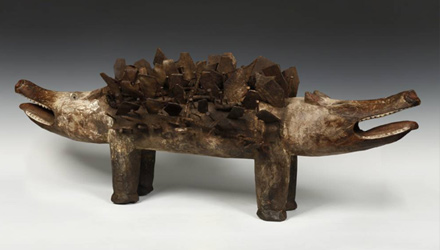 |
Download this Article: Minkisi - Power Figures & Nail Fetishes from Central Africa.pdf